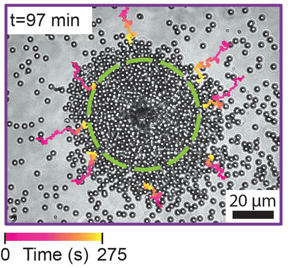Home > Press > Life-like lasers can self-organise, adapt their structure, and cooperate
 |
| Microparticles clustering around a Janus particle. The dashed line delineates the lasing area, and the pink/yellow lines show the tracks of several microparticles
CREDIT Imperial College London |
Abstract:
By mimicking features of living systems, self-organising lasers could lead to new materials for sensing, computing, light sources and displays.
Life-like lasers can self-organise, adapt their structure, and cooperate
London, UK | Posted on July 15th, 2022
While many artificial materials have advanced properties, they have a long way to go to combine the versatility and functionality of living materials that can adapt to their situation. For example, in the human body bone and muscle continuously reorganise their structure and composition to better sustain changing weight and level of activity.
Now, researchers from Imperial College London and University College London have demonstrated the first spontaneously self-organising laser device, which can reconfigure when conditions change.
The innovation, reported in Nature Physics, will help enable the development of smart photonic materials capable of better mimicking properties of biological matter, such as responsiveness, adaptation, self-healing, and collective behaviour.
Co-lead author Professor Riccardo Sapienza, from the Department of Physics at Imperial, said: Lasers, which power most of our technologies, are designed from crystalline materials to have precise and static properties. We asked ourselves if we could create a laser with the ability to blend structure and functionality, to reconfigure itself and cooperate like biological materials do.
Our laser system can reconfigure and cooperate, thus enabling a first step towards emulating the ever-evolving relationship between structure and functionality typical of living materials.
Lasers are devices that amplify light to produce a special form of light. The self-assembling lasers in the teams experiment consisted of microparticles dispersed in a liquid with high gain the ability to amplify light. Once enough of these microparticles collect together, they can harness external energy to lase produce laser light.
An external laser was used to heat up a Janus particle (a particle coated on one side with light-absorbing material), around which the microparticles gathered. The lasing created by these microparticle clusters could be turned on and off by changing the intensity of the external laser, which in turn controlled the size and density of the cluster.
The team also showed how the lasing cluster could be transferred in space by heating different Janus particles, demonstrating the adaptability of the system. Janus particles can also collaborate, creating clusters that have properties beyond the simple adding of two clusters, such as changing their shape and boosting their lasing power.
Co-lead author Dr Giorgio Volpe, from the Department of Chemistry at UCL, said: Nowadays, lasers are used as a matter of course in medicine, telecommunications, and also in industrial production. Embodying lasers with life-like properties will enable the development of robust, autonomous, and durable next-generation materials and devices for sensing applications, non-conventional computing, novel light sources and displays.
Next, the team will study how to improve the lasers autonomous behaviour to render them even more life-like. A first application of the technology could be for next-generation electronic inks for smart displays.
####
For more information, please click here
Contacts:
Hayley Dunning
Imperial College London
Office: 020-759-42412
Copyright © Imperial College London
If you have a comment, please Contact us.
Issuers of news releases, not 7th Wave, Inc. or Nanotechnology Now, are solely responsible for the accuracy of the content.
News and information
![]()
Study reveals new mode of triggering immune responses July 15th, 2022
![]()
A novel graphene based NiSe2 nanocrystalline array for efficient hydrogen evolution reaction July 15th, 2022
Display technology/LEDs/SS Lighting/OLEDs
![]()
Photoinduced large polaron transport and dynamics in organic-inorganic hybrid lead halide perovskite with terahertz probes July 8th, 2022
![]()
A solution to perovskite solar cell scalability problems April 22nd, 2022
Possible Futures
![]()
Recent advances in 3D electronics July 15th, 2022
![]()
Crystal phase engineering offers glimpse of future potential, researchers say July 15th, 2022
Chip Technology
![]()
Atomic level deposition to extend Moores law and beyond July 15th, 2022
![]()
Recent advances in 3D electronics July 15th, 2022
Sensors
![]()
Photonic synapses with low power consumption and high sensitivity are expected to integrate sensing-memory-preprocessing capabilities July 1st, 2022
![]()
Photonic integrated erbium doped amplifiers reach commercial performance: Boosting light power revolutionizes communications and autopilots June 17th, 2022
Discoveries
![]()
Strain-sensing smart skin ready to deploy: Nanotube-embedded coating detects threats from wear and tear in large structures July 15th, 2022
![]()
Crystal phase engineering offers glimpse of future potential, researchers say July 15th, 2022
Announcements
![]()
Recent advances in 3D electronics July 15th, 2022
![]()
Crystal phase engineering offers glimpse of future potential, researchers say July 15th, 2022
Interviews/Book Reviews/Essays/Reports/Podcasts/Journals/White papers/Posters
![]()
Recent advances in 3D electronics July 15th, 2022
![]()
Crystal phase engineering offers glimpse of future potential, researchers say July 15th, 2022
Photonics/Optics/Lasers
![]()
Electrically driven single microwire-based single-mode microlaser July 8th, 2022
![]()
Deep-ultraviolet nonlinear optical crystals: Concept development and materials discovery July 8th, 2022
![]()
Efficiently processing high-quality periodic nanostructures with ultrafast laser July 1st, 2022
![]()
Photonic synapses with low power consumption and high sensitivity are expected to integrate sensing-memory-preprocessing capabilities July 1st, 2022










